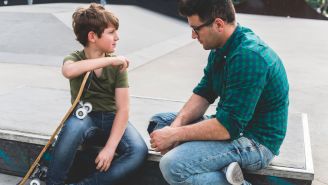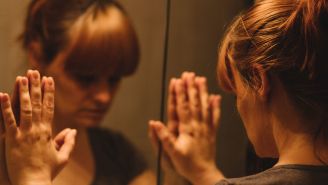Human sex trafficking is a form of modern-day slavery happening globally, where people are forced into commercial sex. In the US, if the individual is under 18, federal law recognizes they're not willing prostitutes, and considers them sex trafficking victims.
“Trafficking means that you're being exploited,” says Michael McKeown, Executive Director of Campaigns and the Homeland Security Advisory Council at the US Department of Homeland Security. “[It] is the use of force for coercion,” he adds.
Who is targeted?
In countries all over the world, including the US, traffickers take advantage of vulnerable people. Frequently, that means those who lack basic human rights and an education. Other common targets include runaway or homeless youth and individuals who’ve endured sexual assault or social discrimination, as well as minority populations, such as Native Americans and Native Alaskans. But at the end of the day, “Anyone can be a victim,” says McKeown. And it’s not just a suburban issue or a rural city issue. “This happens in all 50 states. This happens in every community.”
How does it happen?
Victims are tricked and coerced into the trade under the guise of a better life, often lured by a trafficker falsely promising a brighter future. What the victims don’t realize is the ads they answered for a modeling, waitressing or dancing gig are actually fake. The promises of working in construction or agriculture in urban cities are fake, too.
Once victims get to their new destination, sometimes in another country, traffickers often control them through a form of debt bondage. Traffickers claim their victims need to pay them back for providing transportation or for recruiting them into their so-called job. They are then taken to places like brothels, strip clubs or massage parlors to engage in paid sex acts—or they are prostituted out on the streets. Often times, sex trafficking can occur without even leaving their hometowns.
“Some of these kids, they'll leave their parents' home, go to school, service clients and go back home tomorrow,” says McKeown. Something else McKeown sees: victims being used as recruiters. They seem more trustworthy than a strange man, and can easily be used to lure and approach another victim.
A not-so-trusting relationship
For some, it’s love that gets them in trouble—or what they think is love. “The trafficker will first be a Romeo to some of these people,” says McKeown. Traffickers might meet the victim at the mall or the movie theater. He will gain her trust. Then he will start calling her his “girlfriend.” He will promise to lavish her with presents, like designer clothes, iPhones or handbags. The girl, who is likely a runaway or isolated from family and friends, feels like she is being cared for.
Some traffickers use “trauma bonding” to keep their victims in a cycle of abuse. This form of manipulation instills fear in the victim, but also makes them believe the trafficker loves and cares for them by keeping them alive. “They will promise them love—something that they might not have in their life—and then turn around and it becomes this toxic relationship, and she’s expected to do unspeakable things in order to maintain the relationship,” says McKeown.
How can sex trafficking affect the victim?
Sex trafficking can have devastating mental and physical health effects on the individual. Besides losing a sense of self and control, they often face psychological damage and social marginalization. Similar to other forms of abuse, sex trafficking can cause the victim to develop post-traumatic stress disorder, anxiety, depression and suicidal thoughts. This can lead to drug, alcohol or other forms of substance abuse. In one study, when compared to any other victims of a crime, those who were sex trafficked faced more trauma, fear and isolation. At the Institute of Psychiatry, Psychology & Neuroscience in England, researchers looked at the mental health of 133 victims of sex trafficking. Around 34 percent of the adults had developed depression.
It can also lead to physical trauma. If their trafficker is physically abusive, the victim may have scars, black and blue marks, broken bones or other indicators of harm. They may contract infections and sexually transmitted diseases, such as gonorrhea or HIV. They may be forced to have an abortion.
The signs
If you have a gut feeling that something doesn’t seem right, you can probably trust your intuition. While these signs are not conclusive, they can help you become more aware of your surroundings. Remember: if you’re not sure if someone is a victim, you can always leave an anonymous tip with the Blue Campaign’s hotline at 1-866-347-2423.
Living conditions: Is the person working unusually long hours and being paid little to nothing, except for tips? If they have poor living conditions, appear to be living with employers or have missed school or other obligations for multiple days at a time, it might be a sign.
Body language and verbal expression: An individual’s body language says a lot. Is the person shifting their eyes? Do they look tense, anxious, scared or paranoid? Do they seem distracted? Are they constantly looking around to see if someone, maybe law enforcement, is close by?
Also, pay attention to what the person says. Does it seem scripted and rehearsed? Do they avoid answering questions about who they are, where they’re going and what they’re doing? If so, a trafficker might be controlling their answers.
Physical clues: “I think that what we’re also seeing is that they seem out of place,” says McKeown. For example, do they look malnourished, like their clothes don’t fit, or like they’re unhygienic? Traffickers often deny their victims proper health care. Other indicators might include signs of physical abuse, confinement or torture. Be wary of any physical bruises or marks on the person’s skin. If someone looks like they’ve been denied basic necessities (water, food, sleep), report it.
Look for any signs of branding. Historically, a bar code, a manifesto or big, bold words like “daddy” tattooed across a woman’s chest, thighs or wrists are often used to show ownership.
On the road: Be on the alert if you see someone who is traveling empty-handed, with few to no personal belongings. “Who has access to [their] identity?” says McKeown. Be aware of anyone who seems to not have control over their own identification documents, like a passport or a personal bank account. Do they seem unsure of where they’re going? Does their attire seem off for the route of travel? Is the person dressed for the Artic when you know their destination is tropical? These may all be signs.
At a hotel: Pay close attention to how the person is checking in. Do they have minimal luggage and are they paying with cash? If a woman is checking in with an older man, speaks a different language and looks confused or bewildered, take note. Also, be aware if there are groups of men congregating outside one room or the parking lot.
How to report sex trafficking
In 2017, there were 3,186 cases of sex trafficking reported to the National Human Trafficking Hotline. "Sex trafficking is unacceptable in our society, and there’s a reason why we call it modern-day slavery,” says McKeown. "It’s because there’s no way out and it takes a while for some of these victims and survivors to realize that they hadn’t done this on their own free will. But there are things you can do to help."
“Don’t be a hero, be a do-gooder,” emphasizes McKeown. If you see someone who you think might be a victim of sex trafficking, do not approach them or the trafficker. It could force them into a dangerous situation. Instead, report it. But if the person looks like they are in immediate danger, call 911.
If you have tips about sex trafficking, need access to safety or just aren’t sure where to turn, call the National Human Trafficking Hotline at 1-888-373-7888. It’s a national, toll-free hotline, which is open 24/7, completely confidential and available to anyone in America. You can also text HELP or INFO to “BeFree” or the number 233733.





